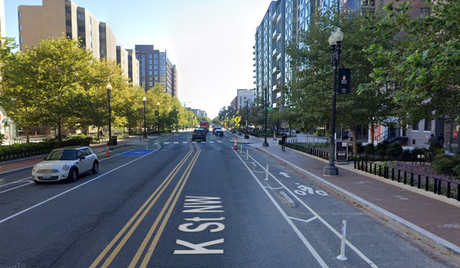 The scene of the crime
The scene of the crimeWhy so many innocent people are going to prison
According to the National Registry of Exonerations, there have 2,551 known exonerations in the United States since 1989. An additional 1,800 defendants have been cleared in 15 large-scale police scandals in which police officers framed innocent defendants. But experts agree that these figures represent the tip of a much larger iceberg. For every innocent person that walks free, a dozen more languish behind bars.
David Black is one of them.
The leading cause of exoneration, involving 72% of wrongful conviction cases, is mistaken eyewitness identification. But when eyewitnesses make mistakes, it is typically because, often unbeknownst to juries, investigators have been manipulating the identification process in subtle, and not-so-subtle ways. This is called police-generated testimony. And if you want to understand how police-generated testimony works, the tragedy of David Black is exhibit A.
The two witnesses that sent David Black to prison were ridiculously, even grotesquely unreliable. If they were in a movie, their performance, in and out of court, would make for high comedy. But there is nothing funny about an innocent man spending twenty-five years in prison.
The star witnesses in the David Black case may have been unreliable, but they were singing from the same hymn book. The details of the story they told a grand jury meshed, right down to the last detail. This likely made a positive impression on the jury.
But what if the story these witnesses told the jury was completely disconnected from reality. What if investigators convinced themselves that the victim was struck by a stray bullet and closed their minds to every other possibility? What if they went looking for witnesses who would tell the story their way? What if they were successful?
So, before we can speak of police-generated testimony, we must examine the story presented at trial on its own terms. Is it consistent with established fact? Is it in sync with the testimony of other witnesses? Does it conform to the simple laws of physics? These questions form the burden of this post.
I have spent the past two decades writing counter narratives for wrongly convicted men and women for Friends of Justice, the non-profit organization I lead. Over fifty people have been exonerated as a consequence of our work.
But we never work alone. I am not operating under the illusion that a series of blog posts can pry open prison bars. We are simply laying a foundation on which other must build: journalists, advocacy groups, pro bono attorneys, and interested readers who forward our work to their friends.
An impertinent question
At the end of a long appeal hearing in 2001, Doug Wham asked permission to call an expert witness. The issue was witness reliability. Specifically, were the two witnesses who sealed the fate of David Q. Black credible under oath? Was their testimony reliable?
Judge Dixon wouldn’t bite. Witness reliability is commonly left up to the jury. Experts might weigh in on technical matters (bullets, shell casings, gun powder residue and bite marks, for instance), but witness reliability is almost always up to the jury.
When Judge Dixon refused to listen to a witness reliability expert, the defense attorney asked an odd question that was as impertinent as it was unusual. The question was unusual. Had Judge Dixon made his ruling after reading through the trial transcript, or was he working “essentially from memory”?
Doug Wham had read the trial transcripts. Several times, in fact. What he found there was mystifying, even chilling. If Larry Johnson and Barbara Marshall didn’t qualify as “unreliable”, nobody did. Their behavior, in and out of the courtroom, was wildly inconsistent. It was a judicial form of theater of the absurd.
An act of violence that horrified a community
Judge Dixon assured his cheeky inquisitor that he had indeed read the trial transcript before handing down his ruling. That said, he also retained vivid memories. “I do remember this trial,” the judge concluded. “I remember Mr. Black and I remember it being a very hard-fought case between counsel. And I remember sweating on the results of the case.”
David Black stood accused of firing a 9mm handgun at James “June Bug” Smith at the conclusion of a loud, lengthy and dramatic argument on the 400 block of K Street in Washington D. C.
The government alleged that, as June Bug fled in a southeasterly direction down K Street, Black walked to his blue Toyota, fished a handgun out of the glove compartment, rested his hands on the roof of the car, and fired two shots. Black didn’t hit June Bug, according to the government’s theory of the case; instead a stray bullet passed through the heart of a diminutive, elderly Chinese-American woman named Alice Chow.
If you didn’t follow all of that, don’t worry, I will break it down in the kind of granular detail the jury never saw.
The senseless killing of Alice Chow horrified the community. Alice Chow had grown up in and around Washington’s Chinatown. Fluent in both Mandarin and Cantonese, she volunteered as an interpreter for Chinese immigrants who spoke little English. She lived a simple, dignified and consequential life, scraping by on Social Security checks and subsidized rent. Her world was within walking distance of her home. Every Sunday morning, she walked to the Saint Mary Mother of God Catholic Church. And every day, come rain or come shine, she walked to the Chinese Community Center housed in the socially conscious Calvary Baptist Church on 8th Street.
Both locations were less than half a mile from her apartment in the Museum Square One apartment building on the corner of K and 4th streets where Ms. Chow served as vice president of the residents’ association.
It had taken six long weeks to apprehend a suspect in the case, and the better part of a year before the went to trial. An acquittal in a case this fraught with sorrow and fear would have sparked outrage.
When Judge Dixon says he “sweated the results of the case,” this was the scenario he likely had in mind.
A godly woman murdered by a godless thug
When Judge Dixon reflected on the trial, one single detail stood out in his mind. The narrative developed at trial had revolved around a church. “I remember that the evidence, as I—either the evidence or someone told me that Mrs. Chow was leaving the church when this occurred, or passing in front of the church, or something of that nature. I do remember this trial.”
I doubt the defense attorney was reassured by this response. Two churches figured prominently in the story developed at trial: St. Mary Catholic Church on H Street, and the tiny Lily Memorial Baptist Church Ms. Chow was approaching on that fatal Sunday afternoon.
Ken Whitted, the man charged with prosecuting David Black, wanted jurors to remember that Alice Chow had been walking home from church when a bullet ended her life. Whitted mentioned this fact in his opening remarks, he worked it into the questions he posed to witnesses, and his closing remarks were studded with reminders.
Whitted didn’t invent this detail. It had appeared in police reports and featured prominently in every story the Washington Post story devoted to the case. The idea of a godly woman gunned down by a profane street punk was guaranteed to shock. It grabbed the attention of the reader and refused to let go. Kenneth Whitted used the image to win a conviction.
It wasn’t true
But it wasn’t true. We don’t know for sure where Alice Chow was headed shortly before 2 pm on February 2nd of 1997. But she wasn’t headed home from church.
It is virtually certain that Ms. Chow had attended church the morning she died. The Saint Mary parish church is located in the heart of historic Chinatown. The Rev. Victor Wong, a personal friend of Ms. Chow, celebrated a Chinese mass at 11:30 on Sunday mornings. Mass lasted just under an hour, and (thanks to Google) we know the walk home would have taken approximately than ten minutes.
Ms. Chow would have had a little more than an hour to eat lunch before heading off to the Chinese Community Center (or wherever else she may have been going).
The wrong spot, and the wrong direction
We can be certain that Ms. Chow was not coming home from church when she died because she was walking away from her apartment building. Three women, chatting on the sidewalk in front of Lily Memorial Baptist Church, saw her collapse no more than thirty feet from where they stood.
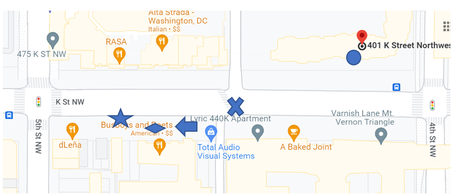
In this map, the star represents Lily Memorial Baptist Church, the circle represents the Museum Square One apartment building where Alice Chow resided, the star is the spot on the sidewalk where three women were chatting after worship, the arrow marks the direction Ms. Chow was walking, and the diamond indicates where she fell.
If, as I suspect, Ms. Chow was walking to the Chinese Community Center (which she visited on a daily basis), she would have crossed K street at the cross walk (marked by the X), turned right (or west) and headed toward 5th Street.
Wherever Ms. Chow was headed just before 2pm on a Sunday afternoon, she clearly wasn’t coming home from church.
As Judge Dixon’s muddled remarks suggest, it is easy to confuse the Catholic Church on H street that Ms. Chow attended that morning, and Lily Memorial Baptist Church, the small Black church she would have passed on her way to 5th Street. Black Baptist worship ends when the Holy Ghost tells the preacher to hang it up, and that typically doesn’t happen until one o’clock. So it was on this Sunday. White worshippers are paying the bill at the restaurant when Black church lets out.
The official story is false and I can prove it
As previously stated, my present purpose is to explain why the official narrative shaped in the course of a four-day trial crumbles under careful analysis. Hear me clearly. I am not arguing for reasonable doubt. I am not suggesting that the official narrative is open to critique. I am saying the official story is objectively and demonstrably false. That it can’t possibly be true. That it is literally nonsense.
I conclude this post with five quick reasons why the government’s narrative in the David Black case is the stuff of fantasy. When I arrive at reason number five, you will understand why it matters that Alice Chow was walking home from church when she died.
- The alleged witnesses were too far from the action to make an accurate identification
My first argument will be covered in some detail because it is critical and counterintuitive. The official narrative features two shots fired from the south side of K Street, immediately across from Lily Memorial Baptist Church (460 K Street). How close do you have to be from a suspect to make a reliable identification?
Fortunately, we don’t have to guess. According to a number of scientific studies, when more than 150 feet separate one person from another, visual recognition drops to zero. Larry Johnson and Barbara Marshall were approximately 250 feet from the scene they described.
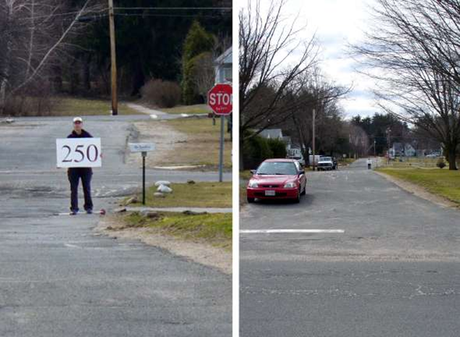
In the picture above, a man is holding a large sign, several times the size of his face. On the left we see a close-up; on the right, we see the view from 250 feet. Not only can you not see the man’s face; you can’t read the sign. Again, this is the distance between the witnesses in the David Black trial and the action they witnessed.
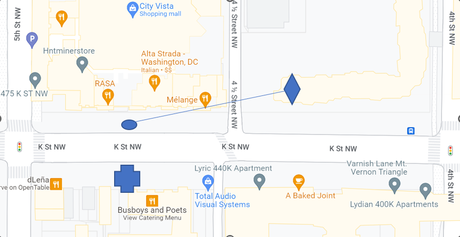
In a 2009 study, test subjects were shown a large picture of celebrity actress Julia Roberts. The test started at a considerable distance and moved progressively closer.
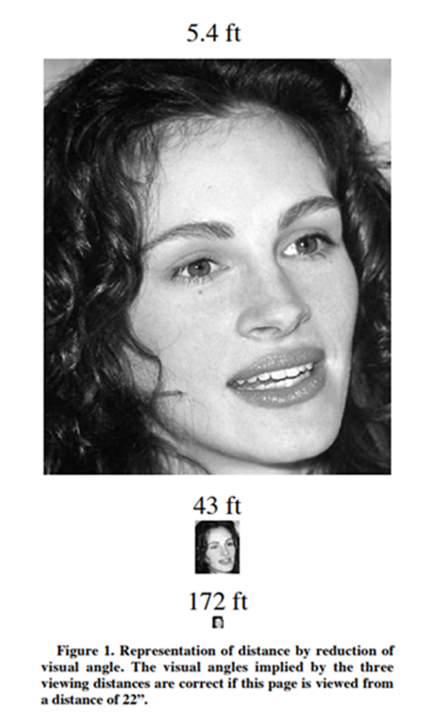
At 5.4 feet, everyone identified Julia Roberts (the lips are a dead giveaway). At 43 feet, some did, some didn’t. At 172 feet, the image was far too small for test participants to even guess at an identification.
At trial, Barbara Marshall admitted that her vision is extremely poor and claimed she wasn’t wearing her glasses on the day Alice Chow died. But even if she and Larry Johnson had enjoyed 20/20 vision, they were simply too far from the scene to identify David Black, or anyone else.
- Witnesses stationed thirty feet from the action saw and heard nothing
According to trial testimony, the government’s star witnesses saw David Black and June Bug arguing on the street across the street from Lily Memorial Baptist Church. They were waving their arms and screaming at one another. The “ruckus” was so loud, in fact, that Larry moved to the window to see what was going on. When Barbara was on-script, she claimed to see the anger on their men’s faces (see point number one). Suddenly, while the two men were standing at the front of the blue Toyota, June Bug raced across K street, angling toward “the alley” (41/2 Street on the map below).
While all this drama was going down, three women were chatting on the opposite side of K street, less than thirty feet away. They heard nothing. They saw nothing. A fleeing June Bug, according to the official narrative, would have passed within ten feet of the women. They didn’t see him.
In the official story, Black fired a 9mm handgun less than thirty feet from the women. They heard a popping sound which, initially, they didn’t recognize as gunfire, but they didn’t see the blue Toyota or a man discharging a weapon. The discharge from a handgun at close range is deafening. That’s why people lose their hearing if they don’t wear ear protectors at the firing range.
It would have been impossible to carry on a polite curb-side conversation with two men screaming at one another immediately across the street. A running man passing within ten feet of the women would have been impossible to miss.
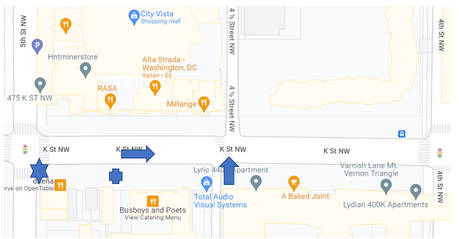
Seconds after Alice Chow collapsed on the sidewalk, Larry Haskell, a resident of 401 K Street, emerged from the alley (41/2 Street NW) and ran in the direction indicated by the arrow to the right. All three women (represented by the cross in the map above) witnessed this sudden burst of action. An assistant pastor who was walking toward 5th Street with a parishioner (see the star above) thought the running man might be the shooter and gave chase.
Yet none of these street witnesses saw the argument, the flight of June Bug, the shooter, or the blue Toyota. There is a simple explanation: they weren’t there.
- If Alice Chow died from a stray bullet, it wasn’t fired from the north side of K Street
By the time the Washington Post described the shooting the day after the incident, the stray-bullet theory was already viewed as established fact. Why would anyone want to shoot an elderly human rights activist on a quiet street? The police weren’t entertaining alternative theories.
But the government’s insistence that Ms. Chow caught a bullet intended for a fleeing June Bug doesn’t bear the weight of scrutiny.
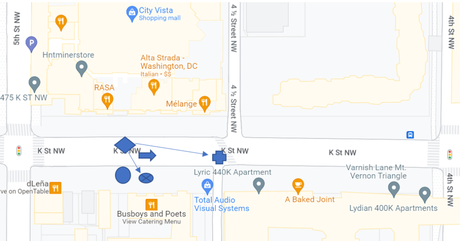
At trial, the government’s star witnesses, (sometimes with considerable coaxing) told the same story. First, June Bug ran in a southeasterly direction down K street (see the arrow in the diagram above). At the same time, Black moved from the front of the car to the passenger side, opened the door, procured a gun, exited the vehicle, placed his arms on the top of the car, and fired two shots.
How long would it take a man, moving quickly and efficiently, to perform that operation. Unless the shooter had to fumble inside the glove compartment or under a seat, it would take at least five seconds.
The average person can run seven meters in one second, which translates to thirty-five meters (114 feet) in five seconds.
You see the problem. For a stray bullet to strike Alice Chow (represented by the crossed oval above) June Bug couldn’t have progressed more than ten feet. Had he run 114 feet, he would have been almost to the crosswalk (marked by the cross). Given a five-second head start, a running June Bug would have been so far east on K street that even the wildest shot would have missed Alice Chow.
- A bullet fired from the south side of K street would have struck the victim on the right side.
The bullet that killed Alice Chow entered her right armpit, passed through her heart, and exited her right armpit. The trajectory was slightly upward. This was clearly established at trial. Ms. Chow’s left side faced the buildings on the south side of K Street; her right side faced the street. The map below contrasts the actual trajectory of the bullet with the trajectory a bullet fired from the north side of K Street.
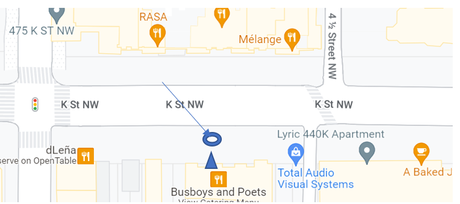
The bold arrow reflects the autopsy report; the arrow coming at an angle across K street represents the government’s theory.
The government’s bad faith solution to these problems
Every problem I have identified should have driven a stake through the heart of the government’s case. Laid out in sequence, the effect is devastating. But David Black’s court appointed attorney rarely engaged the evidence. Maybe he thought the government’s witnesses were so embarrassing that he didn’t have to argue the facts.
By contrast, Assistant U.S. Attorney Ken Whitted was fully aware of these difficulties. His solution was boggles comprehension, but it worked.
If you watch a lot of courtroom dramas, you know every trial concludes with closing arguments from the prosecution and the defense. Then, although it is rarely portrayed on television, the government gets a second closing argument. Because the prosecution must prove its case beyond a reasonable doubt, the theory goes, it must have the first word and the last.
Savvy prosecutors reserve their weakest arguments for the second close because the defense cannot respond.
Since everyone knows that Alice Chow was walking home from church, Whitted reasoned, and since all the evidence suggests she was walking west on K street, she must have been in the process of turning at the crosswalk when the bullet struck her. This explains why her left side was exposed.
With a flick of his hand, Whitted rearranged the crime scene to fit his theory. Trial witnesses were unanimous that Ms. Chow was at least 150 feet past the crosswalk (41/2 Street) when the bullet struck her. Moving the victim that far from the actual crime scene solved two problems with one stroke. It was now possible for a shot fired at June Bug to strike Ms. Chow, and it explained why the bullet struck her left side.
Whitted’s reconstruction of the crime scene was irresponsible, impossible, against all the evidence, and successful.
Remember the man who dashed across the crosswalk at 41/2 Street a seconds after the shooting? His name was Darrell Haskell (I’ll have more to say about him in my next post). If allow the Assistant U.S. Attorney to move the body to the crosswalk, Haskell would have stumbled over her. Haskell’s testimony, corroborated by all the street witnesses who testified at trial, had him moving north across K street at precisely the point Ken Whitted says Ms. Chow fell.
Haskell didn’t trip over Ms. Chow because she wasn’t there. But, of course, he didn’t. She was 150 feet to the west. She was thirty feet from Lily Memorial Church. She was where everyone, with the exception of Mr. Whitted, says she was.
Whitted was lying. He knew he was lying. His lie carried the day.
The jury was taken in by the prosecutor’s sleight-of-hand. They believed Ms. Alice Chow was walking home from church when she died. And Whitted was right, if Ms. Chow had been walking home from church on the south side of K Street, she would have used the crosswalk. But she wasn’t.
I have a different solution to the problems identified in this brief analysis. A solution that doesn’t replace fact with fantasy. Remove David Black, June Bug and the blue Toyota from the picture and everything else makes sense.
But if that’s true, how did what I call the “shooter-runner” theory gain such a firm foothold, and why did two government witnesses bolster that theory when the case went to trial?
Because this is a story about police-generated testimony. More on that next time.
- Police-generated testimony 1: David Black is innocent (and I can prove it)
- A day of reckoning in Winona, Mississippi: Why Fannie Lou Hamer and Curtis Flowers are forever united in a corner of my mind
- Returning to the scene of the crime
- The Science of False Confessions
- What Jonathan Haidt and Yascha Mounk get wrong about the culture war
